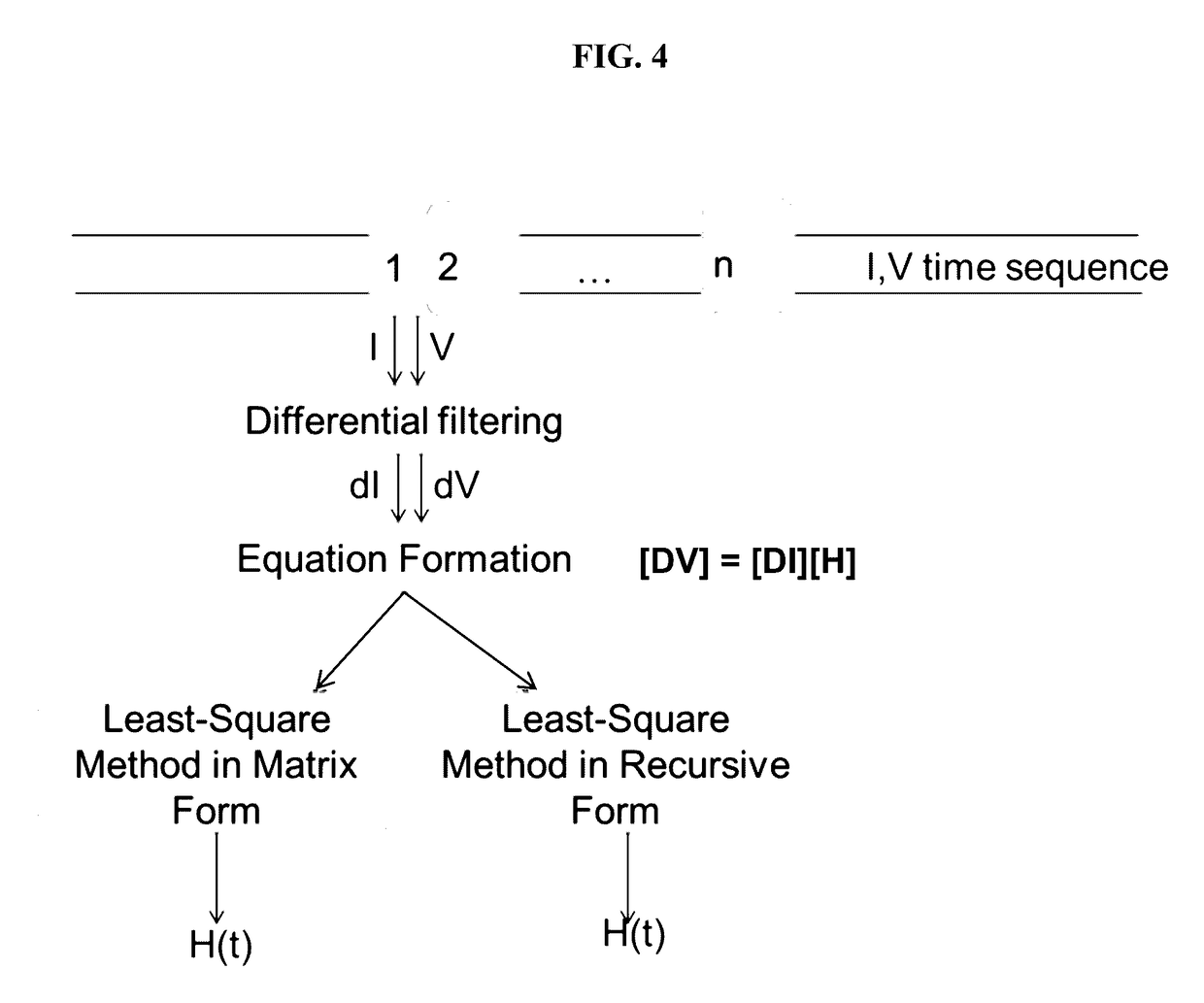Methods and apparatus for dynamic estimation of battery open-circuit voltage
a battery and open-circuit voltage technology, applied in secondary cell servicing/maintenance, electrochemical generators, instruments, etc., can solve the problems of difficult on-line characterization of batteries or fuel cells in vehicles, relatively simple circuit model algorithm, short simulation time, etc., and achieve the effect of improving the stability of characterization
- Summary
- Abstract
- Description
- Claims
- Application Information
AI Technical Summary
Benefits of technology
Problems solved by technology
Method used
Image
Examples
example 1
Linear One-RC Model Simulations
[0212]As one non-limiting example of the simulation tests, a linear one-RC circuit model, as shown in FIG. 2, is used to generate simulated V(t) and I(t) data. The circuit parameters are prescribed as follows: circuit resistance R=0.001Ω; charge-transfer resistance Rct=0.004Ω; diffusion capacitance Cd=250 F; and open-circuit voltage Voc=3.5 V. The current data I(t) are square waves with a frequency of 0.08 Hz and amplitude of 5 A. The sampling interval is 125 msec. Using the current data I(t) and the selected parameters, voltage data V(t) are calculated. As shown in FIG. 6, the I(t) data are simulated square waves, and the V(t) data are the output from the one-RC circuit with the prescribed parameter values.
[0213]Next, I and V data are input into the impulse-response-based algorithm to obtain the impulse response. In the algorithm, we define M=256 and N=128 (see EQ. 4). Equivalently, we sample M+N=384 times of I and V to derive H, which is expected to ...
example 2
One-RC Simulations Using Real-Time Battery Current Data
[0216]In order to demonstrate the capability of the impulse-response-based algorithm to characterize an electrochemical system with measured real-time data, current data as measured from a battery driven in a simulated environment is used to generate voltage data V(t) according to the one-RC circuit model that is similar to the model in Example 1. Without implying a limitation, the one-RC circuit parameters are prescribed as follows: circuit resistance R=0.001Ω; charge-transfer resistance Rct=0.004Ω; diffusion capacitance Cd=250 F; and open-circuit voltage Voc=3.5 V.
[0217]FIG. 7 shows the simulation results in the same format as FIG. 6. FIGS. 7(a) and 7(b) show the driving profiles of current and voltage, respectively. The current data are the measured battery data, while the voltage data are outputs from the one-RC circuit with the prescribed parameter values above. FIG. 7(c) depicts the regressed impulse response H(t). The Nyq...
example 3
Linear Two-RC Model Simulations
[0219]In order to demonstrate the versatility of the impulse-response-based algorithm in some embodiments for different kinds of linear systems, a linear two-RC circuit model, as shown in FIG. 3, is used to generate simulated V(t) and I(t) data. Without implying a limitation, the circuit parameters for the two-RC circuit are prescribed as: circuit resistance R=0.001Ω; first charge-transfer resistance R1=0.0012Ω; first diffusion capacitance C1=500 F; second charge-transfer resistance R2=0.003Ω; second diffusion capacitance C2=3300 F; and open-circuit voltage Voc=3.5 V.
[0220]We use the current data that are measured from a real-time battery driven in a simulated environment to generate voltage data V(t) with the above-defined two-RC circuit. FIG. 8 demonstrates the I and V data used for regression, the derived impulse response H(t), and consequently, the Nyquist plot Z(f) which is the Fourier transform of H(t), and imaginary part of Z verse frequency.
[02...
PUM
 Login to View More
Login to View More Abstract
Description
Claims
Application Information
 Login to View More
Login to View More - R&D
- Intellectual Property
- Life Sciences
- Materials
- Tech Scout
- Unparalleled Data Quality
- Higher Quality Content
- 60% Fewer Hallucinations
Browse by: Latest US Patents, China's latest patents, Technical Efficacy Thesaurus, Application Domain, Technology Topic, Popular Technical Reports.
© 2025 PatSnap. All rights reserved.Legal|Privacy policy|Modern Slavery Act Transparency Statement|Sitemap|About US| Contact US: help@patsnap.com



